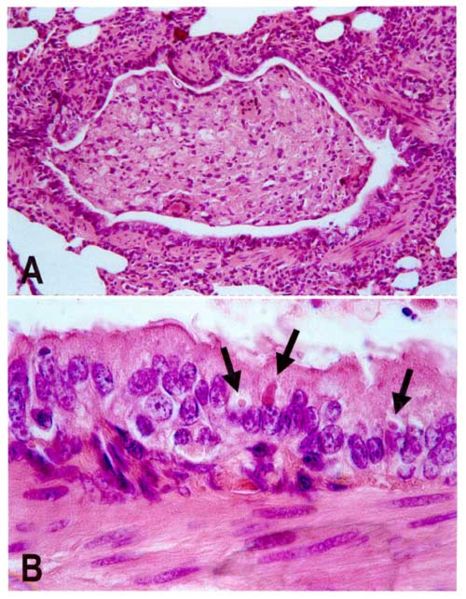Canine distemper
| Scientific classification |
|---|
|
|
Description and significance
“Canine distemper” is a virus of the “Paramyxoviridae” family of the “Mononegavirales” order in the genus “Morbilivirus”; it is closely related to the measles virus. It is known to affect animals in the families Ailuridae, Canidae, Hyaenidae, Mephitidae, Mustelidae, Pinnipedia, Procyonidae. While there is a vaccination that can prevent distemper, the highly contagious viral disease is currently untreatable and often lethal in animals have been affected by it.
History
The first case of canine distemper was discovered in 1905 by Henri Carré, a French veterinarian. It was originally believed to be related to the Plague and Typhus and was also believed to be resulted from several species of bacteria. A vaccine was developed in 1950 that prevents the disease from affecting a treated animal, yet distemper is still prevalent since the vaccine is not accessible to all animals that are susceptible to the virus. The virus was once believed to be a cause of Multiple Sclerosis in humans; however, further research has invalidated this theory and “Canine distemper virus” has no known negative effects on humans. The domestic dog has primarily been responsible for the spread of canine distemper to wildlife, which poses a major ecological threat to several of the disposed species. The virus was a factor in the near-extinction of the black-footed ferret and may have caused the extinction of the Tasmanian tiger. The lion population in Serengeti, Tanzania experienced a 20% decline due to the disease in 1991. The virus has mutated to form “Phocine distemper virus”, which affects seals.
Cell Structure and Transmission
“Canine distemper virus” is a negative-sense, single-stranded RNA virus that is 150–250 nm in length and is enveloped in a protein coat which is encased in a fatty envelope. This fatty envelope is easily disrupted, therefore making it difficult for the virus to survive at room temperature for more than a few hours. Cold and moist conditions increase survival, and it can last for several weeks at near freezing temperatures if kept away from light. The enveloping also causes the virus to be easily inactivated by most disinfectants. For infection to occur, an intact fatty envelope is required. Therefore the virus is relatively unstable outside of the host, and virus transmission entails direct contact between animals or contact with infected body secretions that have been exposed to the environment for a short period of time. [1].
Transmission and Infection
Transmission of is mainly achieved through direct contact with an infected animal's bodily fluids, making the virus highly communicable and extremely contagious. “Canine distemper virus” spreads primarily through aerosol droplet secretions from infected animals, which enters through the respiratory system. Viral shedding occurs approximately 7 days after infection. A viremia causes the spread of the virus in the animal and the infection of all lymphatic tissues, after which the virus spreads to the respiratory system, the GI, the urogenital epithelium the Central Nervous System and the optic nerves, which all become infected and where the virus begins to rapidly reproduce. The intensity of viremia and spread of the virus to other tissues is determined by the level of humoral immunity in the host animal during this period. Once infection occurs throughout the tissues of the body, disease follows. The symptoms of the secondary disease phase include pustular dermatitis and hyperkeratosis of the nose and foot pads and most life-threatening stage of infection is coupled by neurological disorders, including encephalitis associated with myoclonus, seizures, tremors, imbalance, ataxia, and limb weakness. Encephalomyelitis may occur during this time, decreasing the host’s chances of survival. [2].
Genome
The genome is composed of a single non-segmented strand of negative-sense RNA which is 15-19 kilobases long and contains 6-10 genes. The genes are separated by repeated sequences, a polyadenylation signal at the end of the gene, the intergenic sequence GAA, which is followed by a translation start signal at the beginning of the next gene. Extracistronic regions include a 3’ leader sequence that is 50 nucleotides long, which functions as a transcriptional promoter, a 5’ trailer sequence, 50-161 nucleotides long and beginning. [3].
Replication
Current Research
References
McCarthy, A., Shaw, M., Goodman, S. “Pathogen evolution and disease emergence in carnivores”. Proceedings Biological Sciences December, 2007 Vol. 274, No. 1629 p 3165-74.
Gassen, U., Collins, F., Duprex, P., Rima, B.”Establishment of a Rescue System for Canine Distemper Virus”. Journal of Virology, November, 2000, p. 10737-10744, Vol. 74, No. 22
Bjørnstad, O., Pomeroy, L., Holme. E. “The Evolutionary and Epidemiological Dynamics of the Paramyxoviridae”. Journal of Molecular Evolution. February, 2008.. p.98-106 Vol. 66, No. 2
http://www.merckvetmanual.com/mvm/index.jsp?cfile=htm/bc/56700.htm&hide=1
http://en.wikipedia.org/wiki/Canine_distemper#cite_ref-Jones1997_8-5
http://www.microbiologybytes.com/virology/Paramyxoviruses.html
